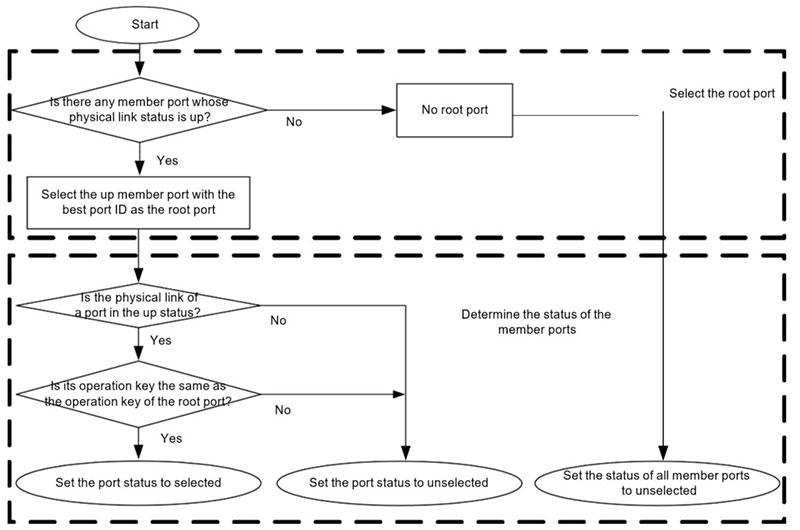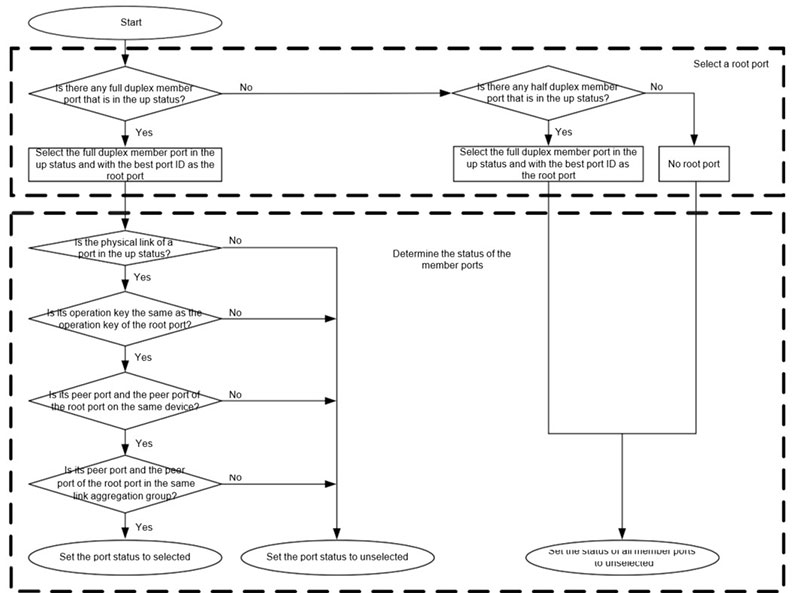Link Aggregation Modes
Link aggregation modes include the static aggregation mode and the dynamic aggregation mode. Aggregation groups are categorized into static aggregation groups and dynamic aggregation groups.
Static Aggregation Mode
In static aggregation mode, the LACP protocol of the member ports of the devices at the two ends is in the disabled status. In the static aggregation group of the local device, set the selected and unselected status for the member ports by following the guidelines as described below:

Figure 1-1 Setting the Status of Member Ports in Static Aggregation Mode
Dynamic Aggregation Mode
In dynamic aggregation ports, a port can join in a dynamic aggregation group in two modes, active or passive.
- If the duplex mode of the port is full duplex:
If the port joins in a dynamic aggregation group in active mode, the LACP protocol is enabled for the port.
If the port joins in a dynamic aggregation group in passive mode, the LACP protocol is disabled for the port. After it receives the LACPDU packets from the peer port, the LACP protocol is enabled.
- If the duplex mode of the port is half duplex, no matter the port joins in a dynamic aggregation group in either mode, the LACP protocol is disabled for the port.
In the dynamic aggregation group, set the selected and unselected status for the member ports by following the guidelines as described below:
First determine the device with a better system ID. Then the device determines the statuses of the member ports of the devices at the two ends. The device with the better system ID sets the selected and unselected status for the member ports by following the guidelines as described below:

Figure 1-2 Setting the Status of Member Ports in Dynamic Aggregation Mode
 Switch
Switch Wifi - Access Point
Wifi - Access Point Firewall
Firewall Router
Router Module Quang
Module Quang![Module Quang Cisco]() Module Quang Cisco
Module Quang Cisco![Module quang HPE]() Module quang HPE
Module quang HPE![Module quang Maipu]() Module quang Maipu
Module quang Maipu![Module quang Brocade]() Module quang Brocade
Module quang Brocade![Module quang Fortinet]() Module quang Fortinet
Module quang Fortinet![Module quang Aruba]() Module quang Aruba
Module quang Aruba![Module quang OEM]() Module quang OEM
Module quang OEM![Module quang Juniper]() Module quang Juniper
Module quang Juniper![Module quang Dell]() Module quang Dell
Module quang Dell![Module quang Palo Alto]() Module quang Palo Alto
Module quang Palo Alto![Module quang Huawei]() Module quang Huawei
Module quang Huawei![Module quang Arista]() Module quang Arista
Module quang Arista![Module quang F5]() Module quang F5
Module quang F5![Module quang H3C]() Module quang H3C
Module quang H3C![Module Quang Allied Telesis]() Module Quang Allied Telesis
Module Quang Allied Telesis![Module quang SonicWall]() Module quang SonicWall
Module quang SonicWall![Module quang Mikrotik]() Module quang Mikrotik
Module quang Mikrotik![Module quang Handar]() Module quang Handar
Module quang Handar Máy chủ (Server)
Máy chủ (Server) Thiết bị lưu trữ (SAN, NAS)
Thiết bị lưu trữ (SAN, NAS) Load Balancing
Load Balancing Video Conferencing
Video Conferencing Phụ kiện máy chủ
Phụ kiện máy chủ Thiết Bị IoT
Thiết Bị IoT Phụ Kiện Mạng
Phụ Kiện Mạng




.png)

























